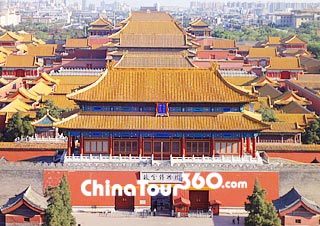 Overall View
Overall View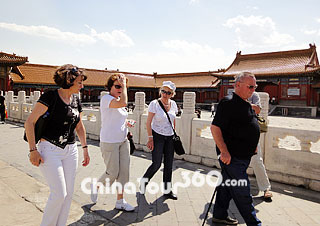 Hall of Supreme Harmony
Hall of Supreme Harmony Gate of Supreme Harmony
Gate of Supreme Harmony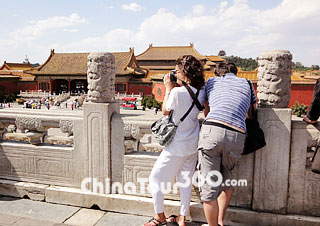 Gate of Heavenly Purity
Gate of Heavenly Purity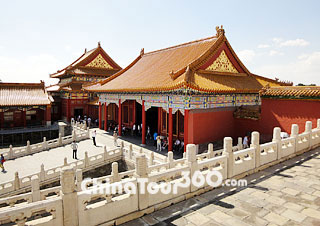 Ancient Imperial Architectures
Ancient Imperial Architectures Tour in Forbidden City
Tour in Forbidden City
![]() Forbidden City Attractions:
Forbidden City Attractions:
Meridian Gate
Hall of Literary Glory & Hall of Martial Valor
Gate of Supreme Harmony
Hall of Supreme Harmony
Hall of Central Harmony
Hall of Preserved Harmony
Gate of Heavenly Purity & Office of Grand Council
Palace of Heavenly Purity
Hall of Union & Peace
Palace of Earthly Tranquility
Imperial Garden
Six Western Palaces
Palace of Gathering Elegance
Hall of Mental Cultivation
Six Eastern Palaces
Nine-Dragon Screen & Hall of Imperial Supremacy
Palace of Tranquil Longevity
Belvedere of Pleasant Sounds, Hall for Viewing Opera & Qianlong Garden
Hall of Spiritual Cultivation, Hall of Joyful Longevity & Bower of Well-nourished Harmony
Gate of Divine Prowess
The Forbidden City in Beijing is the largest one of the five major palaces in the world. The other four are Versailles in France, Buckingham in UK, the Kremlin in Russia and White House in America. It is a truly incomparable masterpiece of ancient architecture, winning fame as the largest and most complete ancient building complex in the world.
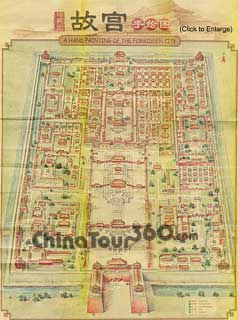 |
| Forbidden City Map |
Located in the city center, it is officially titled the "Palace Museum" in China. However, it is often referred as the 'Forbidden City' in the travel brochures of the western countries, and described as the imperial residence for the royal families of the Ming (1368 - 1644) and Qing (1644 - 1911) Dynasties of China. The name 'Forbidden City' is also said to be related to ancient Chinese philosophy and astronomy. Chinese people believe that there are connections between heaven and human, and the Forbidden City is said to be built according to the legendary Heavenly Palace.
The Forbidden City was built upon the capital of the Yuan Dynasty (1271 - 1368) dunder Yongle's reign in the Ming Dynasty (1368 - 1644). The construction lasted 14 years. Around 500 years from its completion in the Yongle Period to the last emperor of the Qing Dynasty in 1912, it was the imperial palace for 24 emperors, representing the highest power center of the Ming and Qing dynasties. It saw many events involving emperors, empresses, power struggles and religious rituals. Every item in it - every hall, single piece of brick and tile, group of cultural relics, and tree carries its endless imperial stories, reflecting the cultural essence of ancient China.
After the Qing Dynasty (1644 - 1911) fell, especially during the 38 years before 1949, some buildings in the Forbidden City gradually fell into ruin. Many building complexes collapsed, covered by piles of rubbish. In 1961 after the founding of PRC, it was designated as being among China's foremost cultural relic protection sites by the State Council. Thereafter, in the 1950s and 1960s, it received extensive renovation. In 1987, it was listed on the World Cultural Heritage list by UNESCO.
The Forbidden City complex consists of the "Front Hall" and "Inner Palace", surrounded by high walls. It is also encircled by a moat named Tongzi River. Four turrets were set at the four corners of the city walls. On each side of the city walls, there is a gate, namely, Meridian Gate (Wumen) in the south, Gate of Divine Prowess (Shenwumen) in the north, East Prosperity Gate (Donghuamen) in the east and West Prosperity Gate (Xihuamen) in the west.
Based on the outlay and function, the structures in Forbidden City are separated into two sections by the Gate of Heavenly Purity (Qianqingmen), which are the Outer Palace and Inner Court. There are sharp differences between the architectural atmospheres of these two.
The Outer Palace centers on the Hall of Supreme Harmony (Taihedian), the Hall of Central Harmony (Zhonghedian) and the Hall of Preserving Harmony (Baohedian). The Hall of Supreme Harmony is also commonly known as "Throne Room", where emperors granted audiences. It is also called "Front Hall" where emperors rehearsed rites and ceremonies. On its east side are the Hall of Literary Glory (Wenhuadian), the Pavilion of Literary Profundity, the Horse-Managing Yard and Prince Palace. On the west are the Hall of Martial Valor and the Imperial Household Department.
The Inner Palace centers on the Palaces of Heavenly Purity (Qianqinggong) and Earthly Tranquility (Kunninggong), and the Hall of Union and Peace (Jiaotaidian), with the Imperial Garden behind. On Flanking it are the Hall of Mental Cultivation (Yangxindian), Six Eastern(Dongliugong) and Six Western Palaces (Xiliugong), the Hall for Abstinence (Zhaigong), the Hall of Honesty and Respect (Chengsudian). The Inner Palace was the living and entertainment center for emperors and their wives. The Palace of Tranquil Longevity (Ningshougong) in the east was built for Emperor Qianlong's old age after his abdication. In the west are the Palaces of Benevolent Tranquility (Cininggong) and Longevity and Peace (Shouangong). Other famous buildings there are Palace of Double Brilliance (Chonghuagong) and North Five Halls (Beiwusuo).
Apart from being a world-renown palace, the Forbidden City houses almost one million valuable historical and cultural treasures. It receives over six million visitors from home and abroad yearly. In ancient China, it was deemed a crime for ordinary people to walk close to its walls. Today, visitors are free to enjoy its magnificent architectures and splendid history.
![]() Entrance Fee: CNY 60 (Apr. 1 to Oct. 31); CNY 40 (Nov. 1 to Mar. 31)
Entrance Fee: CNY 60 (Apr. 1 to Oct. 31); CNY 40 (Nov. 1 to Mar. 31)
![]() Transportation:
Transportation:
A. Bus Routes: Take Bus No. 1, 2, 4, 5, 10, 20, 22, 52, 54, 57, 120, 802, T1, and get off at Zhongshan Park or Tiananmen bus stop; Take Bus No. 9, 17, 44, 48, 53, 59, 66, 110, 307, 803, 808, 819, 922, T4, T7, and get off at Qianmen bus stop; Take Bus No. 101, 103, 103 (Express), 109, 812, 814, and get off at Forbidden City bus stop.
B. Subway: Take Subway Line 1 and get off at Tiananmen East or Tiananmen West subway station.
![]() Opening Hours:
Opening Hours:
Peak Season (April 1 to October 31): 08:30 - 17:00 (ticket office is closed at 16:00)
Summer Vacation (July 7 to August 26): 08:00 - 17:00 (ticket office is closed at 16:00)
Off Season (November 1 to March 31): 08:30 - 16:30 (ticket office is closed at 15:30)
![]() Please note that since January 1, 2014 the Forbidden City is closed on each Monday (except for national holidays and summer vacation (July 1st - August 31st)) out of relic protection and renovation.
Please note that since January 1, 2014 the Forbidden City is closed on each Monday (except for national holidays and summer vacation (July 1st - August 31st)) out of relic protection and renovation.








